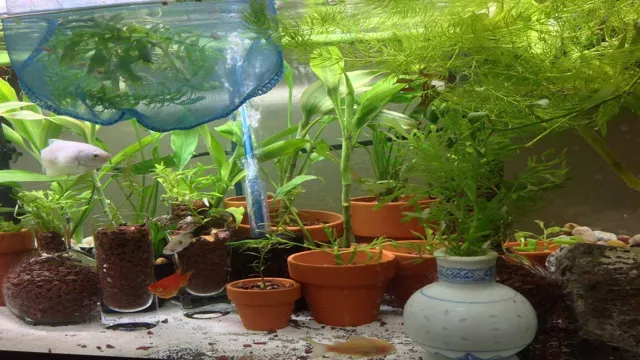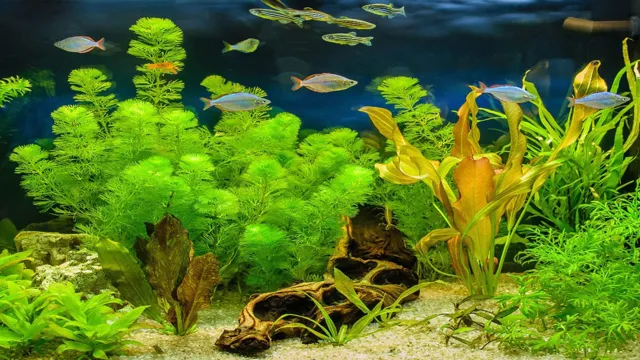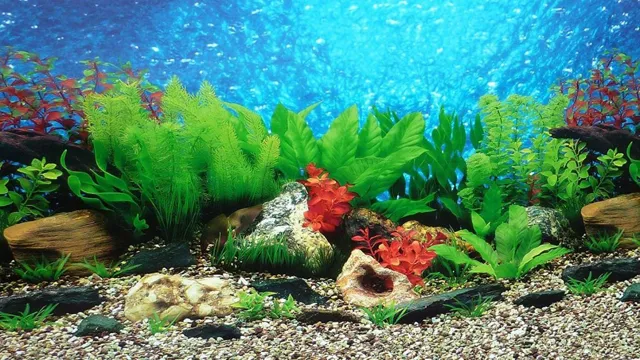If you’re planning on setting up an aquarium, then you’re already aware of the importance of aquatic plants in creating a healthy and thriving environment for your fish. However, many aquarium enthusiasts overlook the crucial step of growing aquarium plants before placing them in their tank. This step can make a significant difference in the growth and health of your aquatic plants, as well as the overall appearance of your aquarium.
In this blog post, we’ll dive into the benefits of growing aquarium plants before tank placement, and how it can create a more successful aquarium experience. So, grab a seat and join us on this adventure!
Introduction
Growing aquarium plants before putting them in your tank is essential to creating a healthy and thriving aquatic environment. The first step is to research the specific plants you want to include in your tank and understand their individual requirements for growth. Many aquarium plants require high levels of light, carbon dioxide, and nutrients, so it’s important to invest in a quality substrate and lighting system.
Next, start growing your plants in a separate container or emersed in water to encourage strong root development and ensure that you can monitor their growth and health before planting them in your tank. As your plants grow, make sure to prune them regularly to encourage bushy growth and prevent overcrowding in your tank. By following these steps, you can ensure that your aquarium plants are healthy and prepared to thrive in your tank.
Why Grow Plants Before Placing Them?
Growing plants before placing them in your garden can have numerous benefits. It may seem counterintuitive at first, but there are many reasons why starting your plants in pots before planting them in the ground is a great idea. First of all, growing plants in pots allows you to control the environment in which they grow.
This means you can choose the best soil mix, fertilizer, and drainage for your specific plants, ensuring they have the best possible chance of success. Additionally, growing plants in pots gives them a chance to establish strong root systems before being transplanted. This can help your plants to better withstand the stresses of being moved, such as wind and changes in temperature.
Finally, growing plants in pots in a greenhouse or indoors can help you get a head start on the growing season, giving you earlier blooms and harvests. So, whether you are a seasoned gardener or just getting started, consider giving your plants a little extra TLC by growing them in pots before planting them in the ground.

Benefits of Growing Plants Before Placement
Growing plants before placement can bring many benefits to your space. Not only do plants add a sense of beauty and tranquility, but research has shown that they can also have positive effects on our mental and physical well-being. Plants improve the air quality by removing toxins and releasing oxygen, which can lead to better concentration and productivity.
Furthermore, greenery has been linked to reducing stress levels and enhancing mood, making them the perfect addition to any interior or exterior environment. By taking the time to grow plants before placement, you can create a more sustainable and enjoyable space for yourself and those around you. So why not consider incorporating some greenery into your life today? Your mind and body will thank you.
Preparing for Plant Growth
Growing aquarium plants before placing them in your tank is an essential step to ensure their survival and growth. To prepare your plants, the first thing to do is to research the species you have and understand their light and nutrient requirements. You can then set up a small outdoor aquarium or a grow tank equipped with all necessary tools like a light source, substrate, and CO2 injections.
Setting up a grow tank will allow you to provide your plants with optimal conditions and monitor their progress closely. It may take a few weeks or even months for your plants to establish and reach their full potential. Once they have grown sufficiently, you can transfer them to your main aquarium.
By taking the time to prepare your plants, you’ll be able to enjoy a healthy and thriving aquatic environment.
Choosing the Right Plants
Preparing for plant growth is a crucial step when it comes to choosing the right plants for your garden. Before you even start selecting your plants, you need to make sure that your soil is in good condition and has the essential nutrients that your desired plants need to survive and thrive. One way to do this is to have your soil tested, which will give you an idea of its pH level and nutrient content.
Based on the results, you may need to add amendments, such as compost or fertilizer, to improve its quality. Additionally, consider the amount of sun, shade, and water that your garden receives throughout the day. This information will help you select plants that are best suited for your garden’s growing conditions.
By following these steps, you’ll be well on your way to creating a healthy and beautiful garden full of thriving plants. (See Also: How to Accelerate Aquarium Cycle: Effective Tips for a Healthy Tank)
Planting in the Right Substrate
To ensure the proper growth and development of plants, it is essential to use the right substrate while planting. The substrate is the material that holds the plant’s roots and provides a firm foundation for growth. It should be a good balance of water retention and drainage to prevent over-watering or under-watering the plant.
Some examples of good substrates are peat, vermiculite, and perlite. The substrate chosen should also match the plant’s needs, such as acidity, nutrient requirements, and root size. For example, cacti and succulents need well-draining soil as their roots absorb water quickly, but they are unable to tolerate wet soil for prolonged periods.
Similarly, a fern requires a substrate with high water retention as their roots absorb water slowly, so a substrate with lower drainage is necessary. Choosing the right substrate is therefore the first and vital step towards ensuring healthy plant growth and a healthy garden.
Providing Adequate Lighting
When preparing for plant growth, providing adequate lighting is essential to ensure that your plant thrives. This means taking into account the type of plant you have and its lighting needs. For example, if you have a plant that requires direct sunlight, you’ll want to place it near a window or under a grow light that emits the same type of light.
On the other hand, if you have a shade-loving plant, you can provide it with artificial lighting that mimics the lower spectrum of light. Additionally, you’ll want to make sure that your plants are receiving the proper amount of light each day. Too much or too little light can stunt growth or even kill your plant.
By making sure you’re providing your plants with adequate lighting, you’ll give them the best chance possible to grow and flourish.
Fertilizing the Plants
Fertilizing the plants is a crucial step in preparing for plant growth. Adding the right nutrients to the soil can make a significant difference in the health and yield of your plants. To determine the appropriate fertilizer, it’s essential to conduct a soil test to identify any deficiencies.
The test results can help determine the right amount of nitrogen, phosphorus, and potassium needed to nourish the plants. Organic fertilizers, such as compost, manure, and bone meal, are a great option as they release nutrients slowly over time, providing a consistent supply of nutrients to the plants. It’s essential to fertilize the plants at the right time and frequency to avoid over-fertilizing, which can lead to burns and stunted growth.
Setting a fertilizing schedule is advisable to ensure that the plants receive the necessary nutrients throughout the growing season. With the right fertilization strategy, you can help your plants thrive and produce a bountiful harvest.
Caring for the Plants During Growth
Growing aquarium plants before putting them in the tank can be an exciting and rewarding experience for aquarists. However, it is crucial to understand the care required during the growth stage to ensure success. First, it is essential to select the appropriate plants for the tank’s size and water parameters.
Once the appropriate plants are selected, ensure sufficient light and nutrients for optimal growth. Water and humidity levels should also be monitored and kept stable. A balanced fertilization routine, incorporating liquid or tablet fertilizers, can help promote plant growth.
Additionally, controlling algae growth can help prevent plant degradation and promote healthy growth. Regular pruning and removal of dead or decaying plant matter are also key to maintaining a healthy and vibrant aquarium. Through proper care and attention during growth, aquarium plants can provide not only aesthetic but also ecological benefits to the aquatic environment.
Maintaining Proper Water Parameters
As an aquarium plant enthusiast, maintaining proper water parameters is the key to keeping your plants healthy and thriving during growth. One important aspect to consider is lighting. Adequate lighting is essential for photosynthesis, which is crucial for the plants to produce oxygen and food.
You should provide your plants with 10-12 hours of light per day, with a spectrum of light suitable for aquatic plants. Another factor to consider is water temperature. Most tropical aquarium plants prefer a temperature between 72-82°F (22-28°C), so make sure to keep your aquarium within this range. (See Also: How to Put a Squid in Your Aquarium Minecraft: A Step-by-Step Guide)
Additionally, maintaining a pH level between 5-5 is crucial for the plants to absorb essential nutrients.
If your pH level is too low or too high, it can harm your plants and negatively affect their growth. Therefore, monitoring and adjusting these parameters regularly is essential for keeping your plants healthy and thriving. Remember, providing the right environment for your aquarium plants is like providing a comfortable home for your pets.
So, just like you would care for your pets, make sure to care for your plants as well.
Pruning and Trimming
When it comes to caring for your plants during growth, pruning and trimming are essential tasks. Pruning is the act of removing dead or overgrown branches and stems to promote growth and ensure the plant’s overall health. On the other hand, trimming involves trimming back the tips of branches or stems to control the plant’s size and promote bushier growth.
Both of these tasks are beneficial in different ways, and knowing which to do when is key. It’s crucial to prune your plants during the dormant season or right before their active growth period. Meanwhile, you can trim your plants any time during the growing season, but it’s best to do it early when the plant is still young.
Remember to use sharp and sterile tools to avoid damaging the plant, and don’t go overboard with cutting. A little bit of pruning and trimming can go a long way in keeping your plants healthy and thriving.
Controlling Algae Growth
Caring for your plants during growth is crucial to controlling algae growth in your aquarium. Algae thrives in conditions that are not suitable for plant growth – for example, in low light conditions or in the presence of excess nutrients. Keeping your plants healthy and happy by providing them with adequate lighting, proper fertilization, and regular pruning will help prevent the growth of algae in your tank.
It’s important to monitor the growth of your plants carefully and to address any issues that arise quickly to keep your tank in balance. Consider the types of plants that are best suited for your aquarium and make sure to provide them with the conditions they need to thrive. With proper care and attention, your plants can help create a beautiful and healthy environment for your fish to thrive in.
Transferring the Plants to the Aquarium
One of the most important factors in growing aquarium plants before putting them in your tank is to first ensure that they are well established and healthy. This involves providing them with the right nutrients, lighting, and temperature in order to promote growth and prevent disease. Once your plants are ready, it’s time to transfer them into your aquarium! To do this, start by thoroughly cleaning your tank and ensuring that the water parameters are suitable for your plants.
Next, remove any plastic containers that your plants may have been growing in, being careful not to disturb the roots. Gently place the plants into the substrate, spacing them out as desired. Be sure to properly anchor any floating plants so they don’t drift away.
Finally, give your plants some time to adjust to their new environment before introducing any fish or other aquatic creatures. With proper care and attention, your aquarium plants should thrive and add a beautiful touch to your underwater oasis.
Preparing the Tank
When it comes to transferring your aquatic plants to the aquarium, it’s important to prepare the tank properly. First, make sure the tank is thoroughly cleaned and free of debris. Then, fill it up with water and add the appropriate amount of aquarium salt.
Next, start transferring your plants from their old container to the aquarium. Gently remove each plant from its container, making sure to remove any excess soil or debris from the plant roots. Carefully place each plant in the aquarium, taking care not to damage the delicate roots.
As you add each plant, make sure to arrange them in a way that provides adequate spacing for growth and allows for the maximum amount of light exposure. With proper preparation and care, transferring your aquatic plants to the aquarium can be a seamless process. (See Also: How to Care for Aquarium Fish: A Comprehensive Guide for Beginners)
Acclimating the Plants to the New Environment
When it comes to transferring your plants to their new home in the aquarium, it’s important to take it slow and ensure they acclimate well to their new environment. First, make sure the water conditions in the aquarium match those of the plant’s previous home as closely as possible. This will reduce stress on the plant during the transition.
It’s also a good idea to slowly adjust the temperature of the water to match that of the aquarium over the course of several days, rather than all at once. Monitor the plants closely during this process and make any necessary adjustments to the water conditions to ensure they are thriving. Once the plants have acclimated to their new home, it’s time to sit back and enjoy the beauty they bring to your aquarium.
Remember to keep up with regular maintenance, including pruning and fertilizing, to ensure your plants continue to thrive. By taking the time to properly acclimate your plants, you’ll set them up for success in their new aquatic environment.
Conclusion
In conclusion, growing aquarium plants before putting them in your tank requires patience, knowledge, and a green thumb (or at least a strong desire to develop one). With proper lighting, nutrients, and carbon dioxide levels in your designated planting container, you can propagate vigorous, healthy plants that will thrive in your aquatic environment. And who knows, you might even become the next aquarium horticulturist champ – the possibilities are as limitless as the plant kingdom itself!”
FAQs
What type of substrate should I use for growing aquarium plants?
The best substrate for growing aquarium plants is one that is nutrient-rich and won’t compact too easily. Some popular options include aqua soil, eco-complete, and gravel with added nutrients.
Can I grow aquarium plants without CO2 injection?
Yes, many aquarium plants can thrive without CO2 injection. However, adding a carbon source like CO2 can greatly enhance the growth and health of your plants.
How much light do aquarium plants need?
The amount of light aquarium plants need varies depending on the species. As a general guideline, most plants need about 8-10 hours of light per day, with a minimum of 2 watts of light per gallon of water.
How often should I fertilize my aquarium plants?
The frequency of fertilization depends on the specific plants you have and their nutrient requirements. In general, most aquarium plants require regular fertilization with a balanced aquarium plant fertilizer.
How long does it take for aquarium plants to grow?
The growth rate of aquarium plants varies depending on the species, lighting, fertilization, and other factors. Some plants can grow several inches or more in a week, while others may take longer to establish and grow.
Can I grow aquarium plants in a low-tech setup?
Yes, it is possible to grow aquarium plants in a low-tech setup without fancy equipment like CO2 injection or high-powered lights. However, you may need to choose hardy plants that can tolerate lower light levels and lower nutrient levels.
How do I prevent algae growth when growing aquarium plants?
To prevent algae growth, it’s important to maintain a good balance of light, nutrients, and carbon sources in your aquarium. You can also add algae-eating fish or invertebrates to your tank, or use chemical or natural remedies to combat algae growth.







